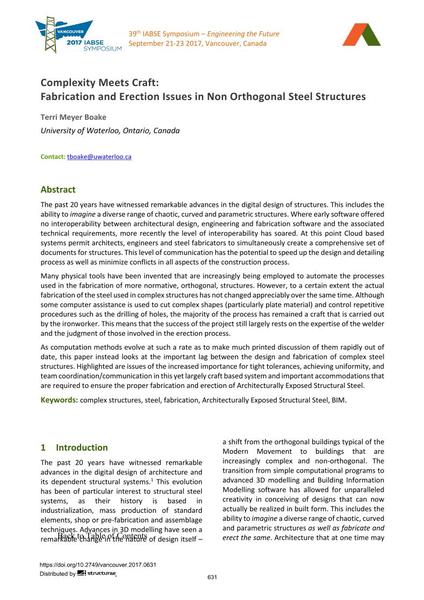Complexity Meets Craft:

|
|
|||||||||||
Détails bibliographiques
| Auteur(s): |
Terri Meyer Boake
(University of Waterloo, Ontario, Canada)
|
||||
|---|---|---|---|---|---|
| Médium: | papier de conférence | ||||
| Langue(s): | anglais | ||||
| Conférence: | IABSE Symposium: Engineering the Future, Vancouver, Canada, 21-23 September 2017 | ||||
| Publié dans: | IABSE Symposium Vancouver 2017 | ||||
|
|||||
| Page(s): | 631-638 | ||||
| Nombre total de pages (du PDF): | 8 | ||||
| Année: | 2017 | ||||
| DOI: | 10.2749/vancouver.2017.0631 | ||||
| Abstrait: |
The past 20 years have witnessed remarkable advances in the digital design of structures. This includes the ability toimaginea diverse range of chaotic, curved and parametric structures. Where early software offered no interoperability between architectural design, engineering and fabrication software and the associated technical requirements, more recently the level of interoperability has soared. At this point Cloud based systems permit architects, engineers and steel fabricators to simultaneously create a comprehensive set of documents for structures. This level of communication has the potential to speed up the design and detailing process as well as minimize conflicts in all aspects of the construction process. Many physical tools have been invented that are increasingly being employed to automate the processes used in the fabrication of more normative, orthogonal, structures. However, to a certain extent the actual fabrication of the steel used in complex structures has not changed appreciably over the same time. Although some computer assistance is used to cut complex shapes (particularly plate material) and control repetitive procedures such as the drilling of holes, the majority of the process has remained a craft that is carried out by the ironworker. This means that the success of the project still largely rests on the expertise of the welder and the judgment of those involved in the erection process. As computation methods evolve at such a rate as to make much printed discussion of them rapidly out of date, this paper instead looks at the important lag between the design and fabrication of complex steel structures. Highlighted are issues of the increased importance for tight tolerances, achieving uniformity, and team coordination/communication in this yet largely craft based system and important accommodations that are required to ensure the proper fabrication and erection of Architecturally Exposed Structural Steel. |
||||
| Mots-clé: |
acier BIM
|
||||
